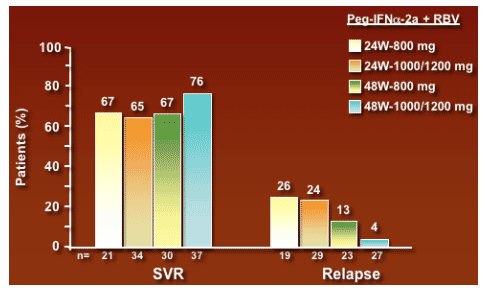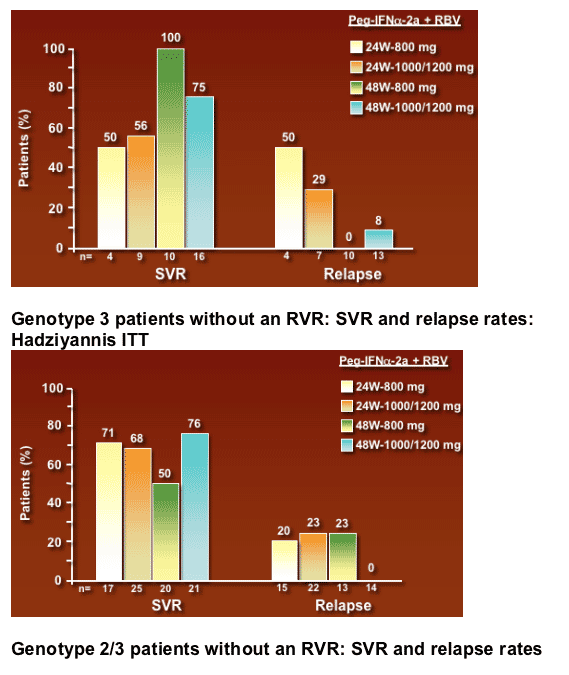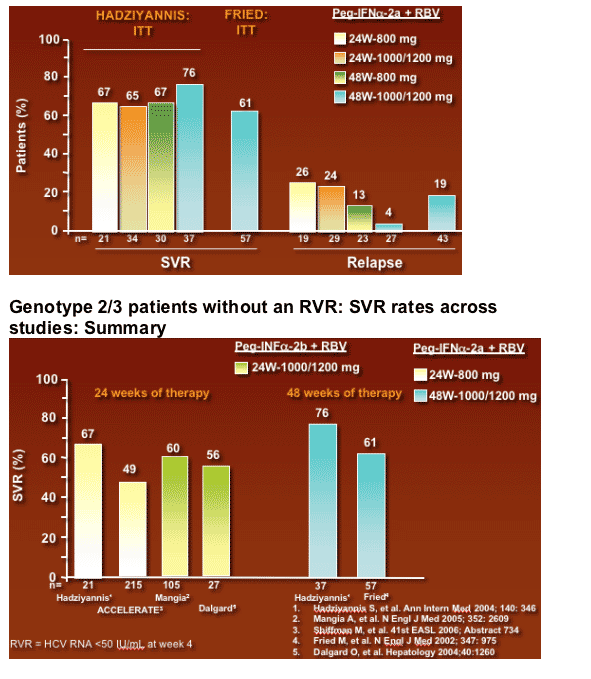 |
 |
 |
| |
Increased SVR rate with 48 weeks' treatment and higher RBV dose in HCV genotype 2/3 patients without a rapid virologic response (RVR) treated with peginterferon alfa-2a (40KD) (PEGASYS) plus RBV (COPEGUS)
|
| |
| |
Bernard Willems1, S.J. Hadziyannis2, T.R. Morgan3,
M. Diago4, P. Marcellin5, D. Bernstein6, P.J. Pockros7, A. Lin8,
M.L. Shiffman9, S. Zeuzem10
1Hopital Saint-Luc-Centre Hospitalier de l'Universite de Montreal, Montreal, Quebec, Canada; 2Henry Dunand Hospital, Athens, Greece, 3VA Medical Center, Long Beach, USA; 4Hospital General Valencia, Spain; 5Hopital Beaujon, France; 6North Shore University Hospital, Manhasset, USA; 7Scripps Clinic, La Jolla, USA; 8Roche, Nutley, USA; 9Virginia Commonwealth University Medical Center, Richmond, USA;
10J.W. Goethe-University Hospital, Frankfurt, Germany
AUTHOR CONCLUSIONS
Genotypes 2/3 are not necessarily "easy-to-treat" genotypes
Patients not achieving an RVR demonstrate disappointing rates of SVR with the recommended 24 weeks of treatment
This retrospective analysis does not allow us to make a firm recommendation for intensifying treatment in all patients, however:
-- Study NV15942 (HADZIYANNIS et al.) showed evidence of increasing rates of SVR and decreasing relapse rates with longer treatment duration and higher doses of ribavirin
-- Comparison to other studies needs to take into consideration baseline factors
Formal prospective studies should be done before 48 weeks treatment duration can be recommended in these patients
BACKGROUND
-- During the treatment of chronic hepatitis C, fast and persistent viral clearance is highly predictive of response and is used to modulate the duration of therapy
-- Patients with genotype 2 or 3 who have a Rapid Virologic Response (RVR) achieve high rates of Sustained Virologic Response (SVR) with 12 to 16 weeks of treatment with pegylated interferon plus ribavirin
-- However, genotype 2/3 patients who do not achieve an RVR have a much lower SVR1-3
-- In the ACCELERATE trial (n=1469), the SVR rate was 90% in patients with RVR and only 49% in patients without RVR4
-- Therefore, genotype 2/3 patients WITHOUT an RVR may benefit from a more intensified treatment regimen (longer duration, higher ribavirin dose)
RVR = HCV RNA <50 IU/mL at week 4
1. Mangia A, et al. N Engl J Med 2005; 352: 2609
2. von Wagner M, et al. Gastroenterology 2005; 129: 522
3. Dalgard O. et al. Hepatology 2004;40:1260
4. Shiffman M, et al. 41st EASL 2006; Abstract 734
In patients infected with genotype 1:
-- Patients with RVR (undetectable HCV RNA at week 4) achieve high rates of SVR (89%) with a shorter duration of 24 weeks1
-- Patients with cEVR (complete Early virologic Response: no RVR but undetectable HCV RNA at week 12) achieve high rates of SVR (67%) with the currently recommended regimen of 48 weeks.2 A longer 72 weeks treatment has been recently showed to be better than 48 weeks3
-- Patients with pEVR (partial Early virologic Response: no RVR and detectable HCV RNA but a >2 log10 drop at week 12) achieve improved rates of SVR (>50%) with an extended treatment duration of 72 weeks4-6
1. Jensen D, et al. Hepatology 2006; 43: 954
2. Marcellin P, et al. 42nd EASL 2007 Abstract 613
3. Mangia A, et al. 42nd EASL 2007; Abstract 7
4. Sanchez-Tapias J, et al. Gastroenterology 2006; 131: 451
5. Berg T, et al. Gastroenterology 2006; 130: 1086
6. Ferenci P, et al. 57th AASLD 2006; Abstract 390
STUDY OBJECTIVE
To determine whether an intensified regimen of 48 weeks of peginterferon alfa_2a (40KD) plus high dose of ribavirin may be beneficial in HCV genotype 2/3 patients who do not achieve an RVR.
METHODS
Data were retrospectively analysed from two randomised, multicentre phase III studies in which patients were treated with peginterferon alfa-2a (40KD) 180 mg/wk plus ribavirin
-- In NV15942, patients were randomised to
24 or 48 weeks of peginterferon alfa-2a (40KD) plus
ribavirin 800 or 1000/1200 mg/day1
This allows a direct within study comparison of SVR rates according to treatment duration and ribavirin dose
-- In NV15801, patients received 48 weeks of peginterferon alfa-2a (40KD) plus ribavirin 1000/1200 mg/day2
PATIENTS
--Treatment naive
--Age ≥18 years
--Quantifiable HCV RNA (>600 IU/mL) in serum
--Elevated serum ALT levels
--Liver biopsy consistent with a diagnosis of chronic hepatitis C
--Compensated liver disease
PROPORTION OF GENOTYPE 2/3 PATIENTS WITH AN RVR
A high proportion of genotype 2/3 patients achieved an RVR in each study:
-- 74% (362/492) in NV15942 (HADZIYANNIS et al.)
-- 58% (81/140) in NV15801 (FRIED et al.)
In a multiple logistic regression analysis, significant independent factors associated with achieving an RVR were:
-- Genotype 2 versus 3 (p<0.001)
-- Non-US region versus US region (p<0.001)
-- Low baseline viral load (HCV RNA <400 000 IU/mL) (p<0.005)
Factors considered: Age, gender, caucasian vs non caucasian, weight, BMI, BSA, G2 vs G3, HCV RNA titer, ALT, cirrhotic vs non cirrhotic, US vs non US, IVDU vs other, ribavirin dose
Genotype 2/3 patients with an RVR: SVR and relapse rates: Hadziyannis ITT
Patients with RVR had 92% SVR with 24 weeks-800mg RBV, 88% with 24
weeks-1000/1200mg RBV. 24 week results were the same or better than 48 weeks: 48 wks-800mg, 87% SVR; 48 wks-1000/1200mg, 82%.

PATIENTS WITHOUT AN RVR
Hadziyannis n = 122
Fried n = 57
Genotype 2/3 patients without an RVR: SVR and relapse rates: Hadziyannis ITT
48 weeks-1000/1200mg RBV appears to show best SVR rate: 76%; compared to 67% for 24 wks-800mg & 48 wks-1000/1200mg, and 65% for 48 wks-800mg RBV. Results appear correlated with relapse rates.

Genotype 2 patients without an RVR: SVR and relapse rates: Hadziyannis ITT
The numbers of patients are small: Genotype 2 patients (n=10) achieved 100% SVR with 48 wks-800mg RBV; 75% SVR with 48 wks-1000/1200mg (n=16). However, 24 weeks yielded much worse results: 50% SVR (n=4) for 24 wks-800mg RBV, 56% for 24 wks-1000/1200mg. Results appear correlated with relapse rates.


|
| |
|
 |
 |
|
|